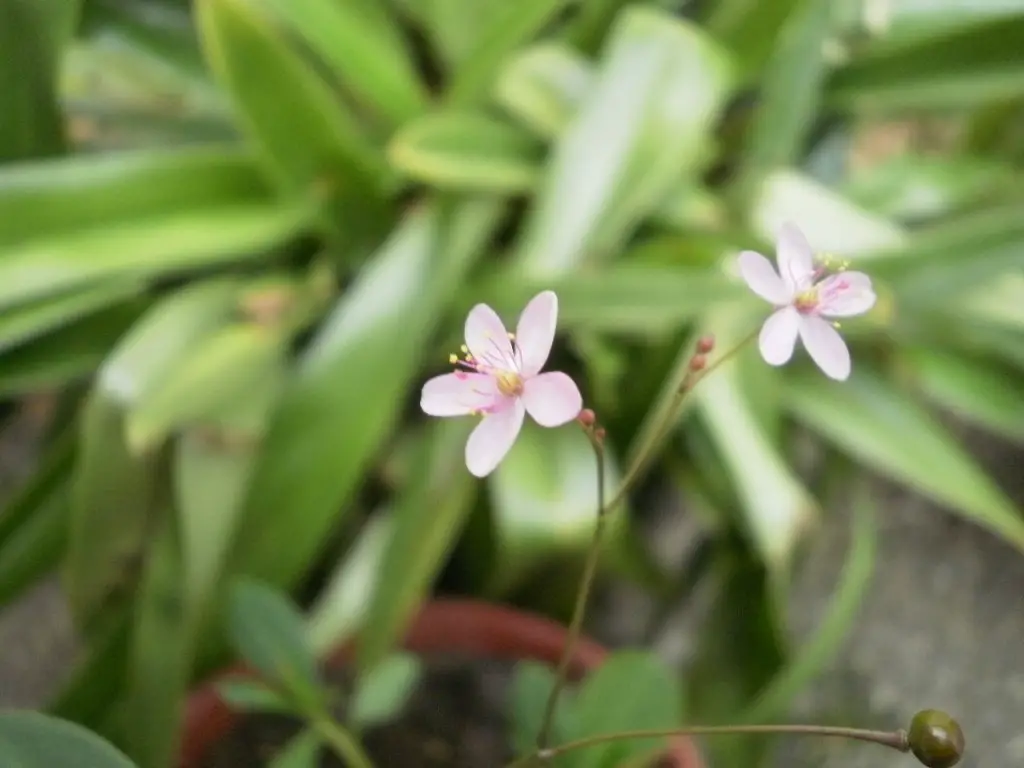If you haven’t come across this plant outdoors, you have likely seen Jewels of Opal in a flower arrangement. The pink flowers against the chartreuse foliage are striking. However, this Jewels of Opar isn’t only for looks— it is also edible.
Talinum Paliculatum: Plant Profile and Aliases
This succulent subshrub is native to tropical America but is also found in many other tropical climates, including the Caribbean, Africa, and Thailand. In the past, it belonged to the Portulacaceae family but now belongs to the Talinaceae family.
Its scientific name is Talinum paniculatum. However, its most common name comes from the book Tarzan and the Jewels of Opar by Edgar Rice Burroughs.
You will often hear this plant referred to as:
What Are You Foraging For Right Now?
We're thrilled to hear your ideas. What would you like to submit today? Feel free to share your thoughts and experiences with us.
- Jewels of Opar
- Pink baby’s breath
- Fame flower
- Limon
- Talinum patens
How to Identify Talinum Paniculatum
You will first notice the beautiful green leaves, usually no more than 12 centimeters long. The chartreuse foliage is eye-catching in any garden.
Most Jewels of Opar grow to be only one or two feet tall, but some grow up to three feet. The small fruit (or “jewel”) is dark red and glossy. The flower panicles usually produce pink flowers, but sometimes they are more of an orange/red color.
It is an erect plant with no noticeable fragrance. The flowers are produced on unbranched stems and are only about 2.6 centimeters/1 inches in diameter.
However, in a large group, the bright color of the flowers is beautiful next to the leaves. If you dig this plant up, you will find a large tuberous root.
Talinum paniculatum is usually found at a low elevation and spreads very quickly. It is common to find this plant in wet fields, wastelands, and rock gardens.


Are Jewels of Opar Perennials?
Yes, these plants are perennials. Once you’ve grown one Talinum paniculatum, you’ll likely always have one, if not five.
The plant grows easily and very quickly from seed, especially if you plant them in the summer.
Are Jewels of Opar Invasive?
If you grow this plant outdoors, it is likely to multiply. It self-sows, and germination begins within only six to fourteen days. The plant roots and proliferates shockingly easily and can produce a long orange root of about 80 centimeters.
This makes the root very difficult to pull out of the ground. If you only pull out a portion, the plant will continue growing. These nomadic seeds are very good at finding new places to live and grow.
Is Talinum Paniculatum Edible?
While most people use this plant ornamentally, you can also eat it. It is a popular ingredient in Africa, Cuba, Southeast Asia, and some countries in America. It is an excellent source of calcium, vitamin A, and vitamin C.
In Thailand, it is used as medicine. Supposedly, it can be used as an aphrodisiac or to treat pulmonary tuberculosis or coughs.
Additionally, in Chinese medicine, Jewels of Opar are called Tu Ren Shen. They are used to treat a Qi deficiency by generating body fluids (breast milk, menstruation, mucus) and moistening the lungs.
How to Use Talinum Paniculatum In the Kitchen
The leaves are the most popular and edible part of the plant. They are similar to spinach and can be used the same way. You can use them raw in a sandwich or a salad.
If you prefer to eat the cooked leaves, you can blanch or stir-fry them or use them in soups and stews.
Ideal Growing Conditions for Jewels of Opar
As warned earlier, these plants grow quickly and easily. However, they do have a few preferences.
Aside from growing best in a tropical environment, Jewels of Opar thrive in full sun but can also handle some shade. In terms of soil, they prefer moist, sandy, organic, rich soil that is well-drained. If the plant is well-established, it is drought-tolerant.
It is a perennial plant that will “die” in a cold winter but almost always comes back to life. They are usually found in USDA hardiness zone 10 or higher.
When growing from seed, it is best to do it indoors because of the seed’s affinity to roam. Start them off in small pots until the plants harden off.
Once they have hardened and the root system is mature, you can transplant them to a larger pot and move them outdoors. Make sure they receive plenty of water for the next few days.
How Do You Care For Talinum?
- In the summer, this plant requires a lot of water
- In the winter, it should still be kept in a sunny place but requires much less water
- Allow the soil to dry out between waterings in the winter
- Over-watering this plant is one of the most common reasons why it might not be thriving
- If the plant gets leggy, you’ll want to trim back the growth after the inflorescence has died
Aside from this, these plants are survivors. Plant with caution because it is likely that the fame flower will take over your garden and pop up in places you didn’t expect.
Originally from Florida, but with a lust for travel, Sami has found herself in many remote areas with little-to-no access to traditional medicines. Since 2014, she has been experimenting with natural remedies, eastern medicine, and foraging. She believes that the Earth provides us with everything we need to live, heal, and cure.

